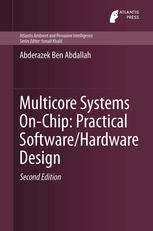

Most ebook files are in PDF format, so you can easily read them using various software such as Foxit Reader or directly on the Google Chrome browser.
Some ebook files are released by publishers in other formats such as .awz, .mobi, .epub, .fb2, etc. You may need to install specific software to read these formats on mobile/PC, such as Calibre.
Please read the tutorial at this link: https://ebookbell.com/faq
We offer FREE conversion to the popular formats you request; however, this may take some time. Therefore, right after payment, please email us, and we will try to provide the service as quickly as possible.
For some exceptional file formats or broken links (if any), please refrain from opening any disputes. Instead, email us first, and we will try to assist within a maximum of 6 hours.
EbookBell Team

5.0
30 reviewsSystem on chips designs have evolved from fairly simple unicore, single memory designs to complex heterogeneous multicore SoC architectures consisting of a large number of IP blocks on the same silicon. To meet high computational demands posed by latest consumer electronic devices, most current systems are based on such paradigm, which represents a real revolution in many aspects in computing. The attraction of multicore processing for power reduction is compelling. By splitting a set of tasks among multiple processor cores, the operating frequency necessary for each core can be reduced, allowing to reduce the voltage on each core. Because dynamic power is proportional to the frequency and to the square of the voltage, we get a big gain, even though we may have more cores running. As more and more cores are integrated into these designs to share the ever increasing processing load, the main challenges lie in efficient memory hierarchy, scalable system interconnect, new programming paradigms, and efficient integration methodology for connecting such heterogeneous cores into a single system capable of leveraging their individual flexibility. Current design methods tend toward mixed HW/SW co-designs targeting multicore systems on-chip for specific applications. To decide on the lowest cost mix of cores, designers must iteratively map the device’s functionality to a particular HW/SW partition and target architectures. In addition, to connect the heterogeneous cores, the architecture requires high performance complex communication architectures and efficient communication protocols, such as hierarchical bus, point-to-point connection, or Network-on-Chip. Software development also becomes far more complex due to the difficulties in breaking a single processing task into multiple parts that can be processed separately and then reassembled later. This reflects the fact that certain processor jobs cannot be easily parallelized to run concurrently on multiple processing cores and that load balancing between processing cores – especially heterogeneous cores – is very difficult.